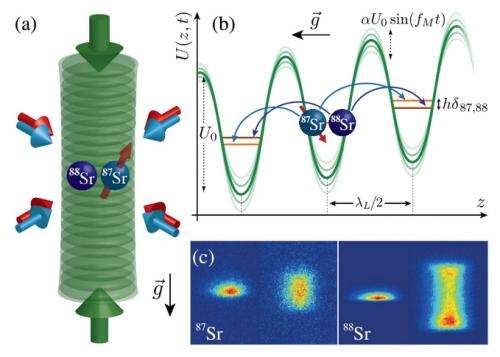Experimental configuration to test the equivalence principle, in which two strontium isotopes are laser-cooled and trapped in a vertical optical lattice. Credit: Tarallo, et al. ©2014 American Physical Society
(Phys.org) —Einstein's equivalence principle states that an object in gravitational free fall is physically equivalent to an object that is accelerating with the same amount of force in the absence of gravity. This principle lies at the heart of general relativity and has been experimentally tested many times. Now in a new paper, scientists have experimentally demonstrated a conceptually new way to test the equivalence principle that could detect the effects of a relatively new concept called spin-gravity coupling.
The study, by M. G. Tarallo, et al., is published in a recent issue of Physical Review Letters.
"Testing the equivalence principle, or the equivalence of inertial mass and gravitational mass, means testing the validity of one of the fundamental principles of general relativity," coauthor Guglielmo Tino, Professor at the University of Florence, INFN, told Phys.org. "In our experiment, we use a quantum sensor to investigate gravitational interaction; this allowed us to search for new effects."
As the researchers explain, there are a variety of ways to test the equivalence principle. These methods include studying the motion of moons and planets, the use of torsion balances, and—more recently—atom interferometry.
In the new study, the researchers have for the first time tested the equivalence principle by comparing the gravitational interaction for a bosonic particle to that of a fermionic particle. For the purpose of the experiment, the important difference between the two particles is that the bosonic particle (a strontium-88 isotope) has no spin, while the fermionic particle (a strontium-87 isotope) has a half-integer spin.
In order to determine how the differences in spin might affect a particle's gravitational interaction, the researchers performed tests to measure each isotope's acceleration due to gravity. These tests consist of confining atomic wave packets in a vertical laser standing wave, and then using a quantum effect involving delocalization to measure the effects of gravity. The new method improves the measurement precision by more than an order of magnitude over previous methods.
The results of the experiments enabled the researchers to set an upper limit of 10-7 on the boson-to-fermion gravitational constant ratio. The researchers also searched for a dependence of gravity acceleration of strontium-87 isotope on the spin direction, but found no evidence for it.
"There are theoretical models predicting that spin and gravity should couple; that is, depending on its spin a particle should behave in different ways in a gravitational field," Tino said. "We found no evidence for that. Since we compared an atom with spin with one without spin, this is a rather stringent test. Also, in our experiment one atom is a boson and the other is a fermion and, again, we found no difference in their behavior in a gravitational field."
The results could have future applications in connection with optical clocks made of strontium, which have already demonstrated impressive stability and accuracy. In the future, it may also be possible to perform an experiment in space using a strontium optical clock and a strontium interferometer to perform stringent tests of general relativity and gravity.
"Our result reported in this paper, as well as the one we recently published on the measurement of the gravitational constant with atoms (G. Rosi, et al.), shows the great potential of quantum sensors based on ultracold atoms and atom interferometry to investigate gravity," Tino said. "We want to try new schemes to increase the sensitivity of the atom interferometer; this would allow us to perform still more stringent tests and search for new effects."
More information:
— M. G. Tarallo, et al. "Test of Einstein Equivalence Principle for 0-Spin and Half-Integer-Spin Atoms: Search for Spin-Gravity Coupling Effects." Physical Review Letters. DOI: 10.1103/PhysRevLett.113.023005
Also at arXiv:1403.1161 [physics.atom-ph]
— G. Rosi, et al. "Precision measurement of the Newtonian gravitational constant using cold atoms." Nature. DOI: 10.1038/nature13433
Journal information: Physical Review Letters
© 2014 Phys.org























